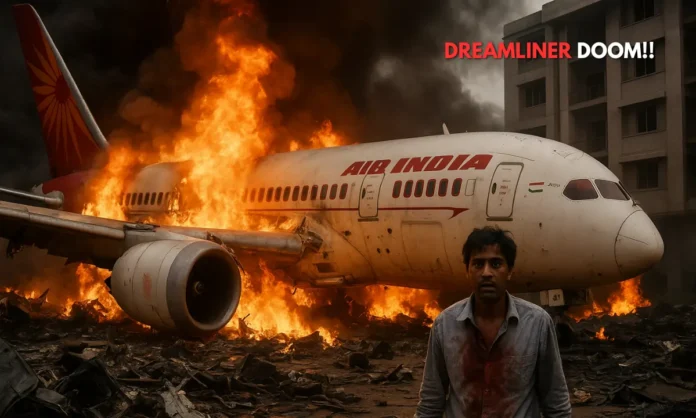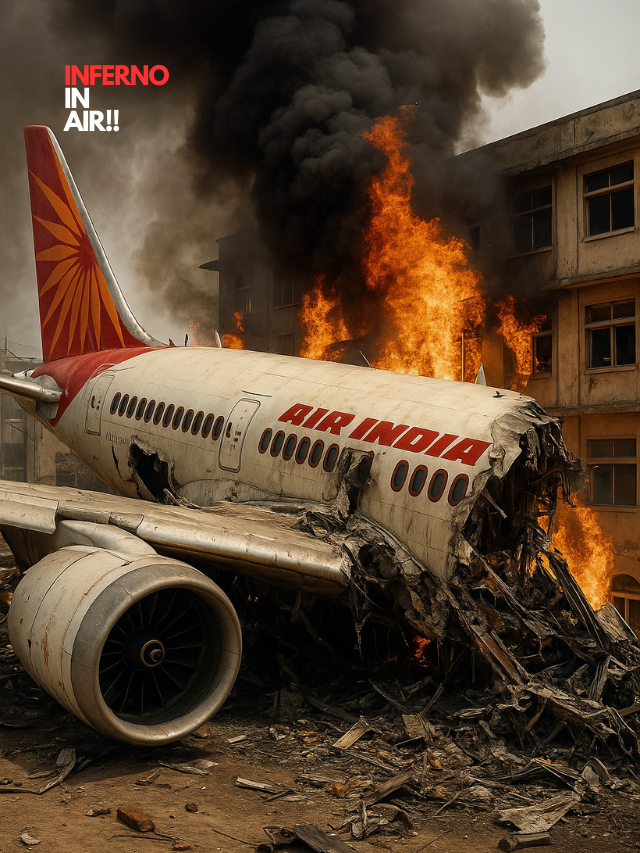- Air India Flight AI171 crashes into a hostel moments after takeoff from Ahmedabad, killing over 240 people.
- Boeing 787-8 Dreamliner suffers first-ever fatal crash; survivor recalls explosion, fire, and chaos.
- India, UK, and U.S. launch high-level probes; aviation industry faces renewed scrutiny amid global shock.
A City Shattered, a Nation Stunned: The Day the Dreamliner Went Down
Ahmedabad’s skies darkened with smoke and sorrow on June 12, 2025, as an Air India Dreamliner bound for London’s Gatwick Airport exploded into flames moments after takeoff. The aircraft, carrying 242 people, crashed directly onto a medical college hostel during the lunch hour, making it India’s worst air disaster in over a decade—and the first-ever fatal crash involving the Boeing 787-8 Dreamliner.
Of the 242 onboard, just one man survived: Ramesh Viswashkumar, a British national of Indian origin seated in 11A next to an emergency exit. His testimony paints a picture of sheer terror—of bodies strewn across the wreckage, of deafening blasts, of blood and fire and survival.
The disaster stunned not only India but the global aviation community. The loss of 240+ lives, including British and Portuguese nationals, sparked rapid international coordination between India, the U.K., the U.S., Boeing, GE Aerospace, and federal regulators. And it raised troubling questions about aviation safety, corporate responsibility, and the future of India’s newly privatized flag carrier.
🔥✈️ Sole Survivor Escapes Air India Fireball Through Broken Exit
— PiQ (@PiQSuite) June 13, 2025
Ramesh Viswashkumar survived India’s deadliest crash in a decade by crawling out of a shattered emergency door as the jet slammed into a hostel.
He recalls green lights, a jolt midair, and flames engulfing the… pic.twitter.com/nDgaTesacY
The First Shock: How a Routine Takeoff Became a Mass Casualty Event
- The Boeing 787-8 Dreamliner took off at 1:39 PM from Ahmedabad, then issued a Mayday before losing all communication.
- It crashed onto a medical college hostel, causing secondary casualties among students and staff.
- The flight included 169 Indians, 53 Britons, 7 Portuguese, and 1 Canadian.
Flight AI171 was expected to be routine. Instead, it became a horror story in seconds. CCTV footage captured the aircraft taking off over residential blocks and then disappearing behind rooftops—moments before a fireball erupted in the background.
Early air traffic records show the aircraft had made a distress call just seconds after takeoff. Witnesses reported seeing the plane flying unusually low with its landing gear still deployed—a red flag in aviation diagnostics.
The aircraft clipped the top of the college building, scattering bodies and wreckage across the campus. Former Gujarat Chief Minister Vijay Rupani was among the deceased, authorities later confirmed. Of the 242 on board, 217 were adults, 11 children, and 2 infants.
Ramesh Viswashkumar, the lone survivor, told the Hindustan Times: “Thirty seconds after takeoff, there was a loud noise… I ran when I saw bodies all around me. Someone pulled me into an ambulance.” His brother Ajay, seated elsewhere, remains missing.
The Global Aftershock: Industry Turmoil and a High-Stakes Investigation
- U.S. and Indian authorities have launched a multi-agency investigation involving Boeing, GE Aerospace, and the FAA.
- Boeing CEO and top executives cancel Paris Air Show attendance; Air India faces mounting scrutiny.
- The crash casts a shadow on Tata Group’s Air India revival and Dreamliner safety claims.
Boeing shares fell 5% following the incident—its worst drop this year—raising fears of another prolonged safety crisis like the 737 MAX scandal. This crash is a significant blow not only to Boeing’s Dreamliner program but also to the Tata Group’s high-profile revival of Air India.
Civil Aviation Minister Ram Mohan Naidu confirmed a full-scale Aircraft Accident Investigation Bureau inquiry. “We are assembling a high-level committee from multiple disciplines,” he stated, acknowledging that the tragedy has both national and international implications.
Meanwhile, GE Aerospace and the FAA have dispatched teams to India to retrieve cockpit data and perform diagnostics. Aviation safety expert Anthony Brickhouse noted from video footage that the landing gear was down during ascent—a dangerous anomaly that suggests severe mechanical failure or software mismanagement.
Britain’s Foreign Office and U.S. Transportation Secretary confirmed coordination efforts with Indian agencies. In the UK, Prime Minister Keir Starmer called the crash “devastating,” while King Charles was said to be closely monitoring the situation. U.S. President Donald Trump termed it “terrible” and extended condolences.
A Nation in Mourning, and a Future in Flux
- PM Modi calls the crash “heartbreaking beyond words,” as Ahmedabad reels from shock and grief.
- DNA sampling underway to identify remains; airport operations resume with restrictions.
- Survivors’ families demand answers on maintenance, pilot training, and fleet safety.
In the aftermath, Ahmedabad turned into a city of silence. The airport reopened with limited flights, while hospitals filled with grieving relatives lining up to provide DNA samples. Eyewitnesses described scenes of horror as people jumped from burning hostel balconies. One mother, Ramila, said her son was injured leaping from the second floor during lunch break.
“The sky fell today,” a grieving relative said at the crash site.
Questions loom large over Air India and the broader aviation regulatory ecosystem. Why did a ten-year-old Dreamliner—maintained by a flagship carrier—fail so catastrophically in ideal weather conditions? Could a design flaw be at play? Or was this a tragic accumulation of smaller errors—pilot fatigue, maintenance gaps, or lax oversight?
Civil society groups and aviation watchdogs are now demanding transparency not only from Air India but from Boeing and GE. The global implications could reshape aircraft certification norms and airline accountability across Asia and Europe.
Final Descent: A Tragedy That Will Haunt Two Continents
The 2025 Ahmedabad crash is not just a tragedy for India—it is a moment of reckoning for global aviation. As regulators race to identify what went wrong, the wreckage has become a symbol of the fragility of modern air travel and the weight of lives suspended between ambition and oversight.
This was the Dreamliner’s first fatal crash. But for the families of the 240+ who perished, that statistic is no comfort. For them, and for India, June 12 will remain a date marked not by departure—but by devastation.



